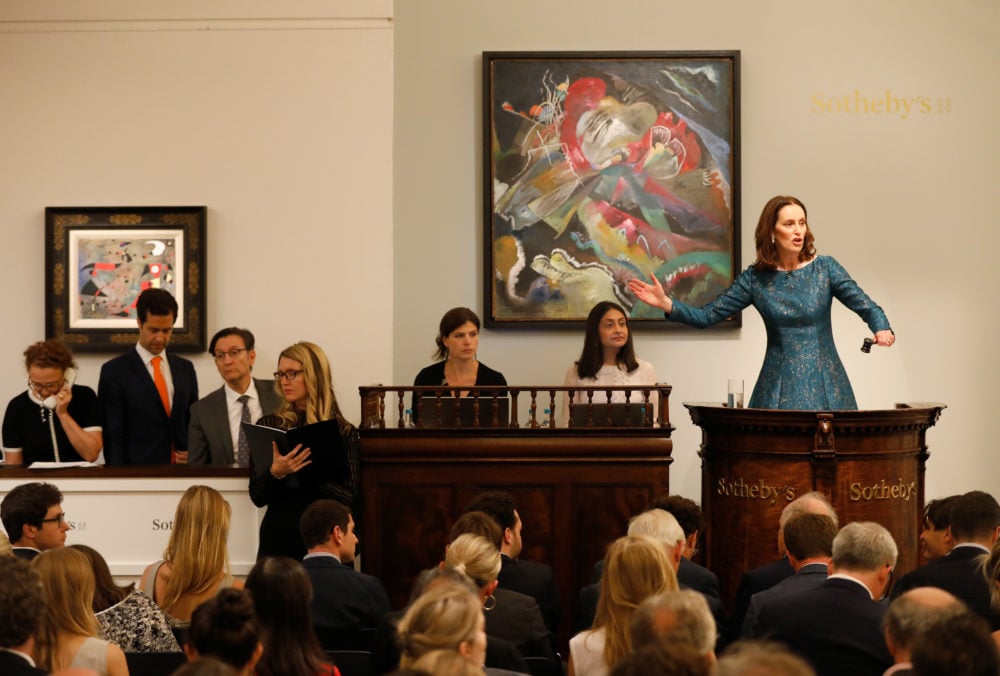
At Sotheby’s Impressionist and Modern art sale in London on Wednesday—held at the end of the longest, steamiest day of the year—the record for a work by the Russian master Wassily Kandinsky was broken twice in less than an hour.
Compared to last June’s thin, 27-lot auction, which fetched £103.3 million, this 58-lot sale seemed to confirm the drought was over. All told, the sale made £149 million ($187.7 million), within the pre-sale estimate of £130–170.5 million. (Final sales prices include the buyer’s premium; pre-sale estimates do not.)
But while the total represented a 45 percent increase on last year, bidding was rarely electric and few lots sold above estimate. The exceptions, apart from Kandinsky and the odd Picasso and Giacometti, were the contemporary works in the Actual Size sale, which acted as an otherwise slightly uneventful aperitif to the main course.
The new, themed addition to the evening, which preceded the regular Impressionist and Modern sale but is included in the £149 million total, offered 36 small works that are the same size as their reproductions in the catalogue.
Ed Ruscha’s Blue Scream (1964) (est. £700,000-1,000,000). Photo courtesy of Sotheby’s.
Petite works on paper by Ed Ruscha and Mark Grotjahn added life to the section, as did an Old Master flower painting by Ambrosius Bosschaert, bought by an Asian collector within estimate for £3 million. The themed sale’s best return was for Ruscha’s Blue Scream (1964), bought four years ago for $554,500 and sold tonight for £1.6 million ($2 million).
That the Impressionist and Modern sale would hit its estimate was a foregone conclusion. Approximately 66 percent of the sale’s low estimate was guaranteed with irrevocable bids. These were concentrated primarily on just four lots. The first was Joan Miró’s Femme et Oiseau, a superb 1940 work on paper from his sought-after but rare “Constellation” series.
The last comparable example from the series surfaced at auction 15 years ago; this one came straight to Sotheby’s from an exhibition at New York’s Acquavella Galleries that closed just last month. The work carried a guarantee within the region of the record-busting estimate, in excess of £23 million ($30 million). The previous record for Miró was £23.6 million ($37 million), set in 2012 for the 1927 oil painting, Peinture (Etoile Bleue).
Joan Miró ‘s Femme et Oiseaux (1940). Image courtesy of Sotheby’s London.
At Sotheby’s this evening, as dealer Bill Acquavella watched intently, there appeared to be only one bidder for the work: the guarantor. Although there were no fireworks, the picture sold for £24.6 million ($31 million)—a record in pounds nonetheless. The work last sold at auction (though not to the consignor) in 1984 for £407,000.
Two lots later, there was no guarantee needed for Kandinsky’s Fauvist period landscape painting of the bucolic German town of Murnau (pre-sale estimate: £15–25 million). Although not stated in the catalogue, the 1909 work had come from the Werner and Gabrielle Merzbacher Collection in Switzerland.
The picture attracted some big telephone bidders and sold within estimate for a record £21 million ($26 million). The last comparable painting at auction fetched £13.5 million in 2013.
Wassily Kandinsky’s Murnau – Landschaft mit grünem Haus , oil on board (1909) (est. £15-25 million). Image courtesy of Sotheby’s.
But this newly minted Kandinsky record did not stand for long. Just six lots later, a rare example from Kandinsky’s move into abstraction in 1913, Painting with White Lines, hit the block. It was guaranteed in excess of $35 million (£27 million)—some say by the US collector Ronald Lauder.
The picture had remained in Russia all its life until 1974, when it was acquired from the State Tretyakov Gallery in Moscow by Cologne collector William Hack, whose descendants are now selling it. (Hack had offered important political archive material to President Brezhnev’s government in exchange for the painting.)
Wassily Kandinsky’s Bild mit weissen Linien (1913). Image courtesy of Sotheby’s.
Four bidders chased the work, including the art adviser Hugo Nathan, whose client, a London-based German collector, was sitting next to him. They finally beat off competition from an Asian phone bidder to buy the work for £33 million ($41.6 million) to thunderous applause—especially from Sotheby’s staff.
Kandinsky’s previous auction record was $23.3 million, set at Christie’s New York last year for a large 1935 painting, Rigide et Courbe. But for a key comparison with another painting from this vitally important period in his career, we have to go back to the peak of the 1990 art market boom, when his Fugue (1914), from the Solomon R. Guggenheim Museum, sold at Sotheby’s for $21 million. (Accounting for inflation, that figure is equivalent to $39.3 million in 2017—still less than tonight’s record-setting Kandinsky.)
Théo Van Rysselberghe’s L’Escaut en amont d’Anvers, le soir (1892). Image courtesy of Sotheby’s.
The other notable record price of the evening was for Théo van Rysselberghe’s luminous pointillist painting, Sailboats on the Escault (1892), which had been bought in 2002 for a record $2.6 million. Now guaranteed, it sold within estimate for £8.5 million ($10.7 million).
Leaving the salesroom, I quizzed London-based adviser and Russian art expert Alex Lachmann on the Kandinskys. “The Murnau landscape was a jewel,” he said, but the 1913 abstraction was “not as good as the one the Guggenheim sold in 1990. It’s just that there aren’t any others like that available on the market.”
The action continues next Tuesday at Christie’s Impressionist and Modern Art sale, which carries a similar pre-sale estimate.